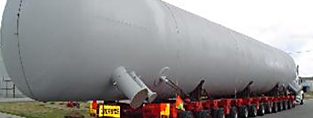
- (03) 5909 8218
- enquiry@fusionweld.com.au
Precautions and Safety for Compressed Air Receiver Vessels
December 3, 2015

Air receiver vessels are front and centre on the design calendar today. A dominant outline in countless industrial and commercial settings, the vessels store energy in the form of air. Popular everywhere, you'll find them powering air tools in garages. They store pressurized air for pneumatic valves, sand blasting shops and tyre repair workshops, sticking to this accomplished task when installed in mines and a hundred other hard working locations. A motorized compressor is working flat out in each scenario, pumping pressurized air into a robust vessel, but are they working safely? Adopt a safe operating strategy and take every precaution when installing, operating, and maintaining these super-popular products.
Maximum Air Pressure Concerns VS. Non-Toxic Contents
Air is what we breathe, so, unlike fuels and corrosive chemicals, you know compressed air receiver vessels won't leak a hazardous gas into your work area. Regardless of this piece of good news, the vessel is rated for a maximum design pressure, and this air is far from pure. Oils, water infiltrating agents, and other pollutants can enter the system. The first precaution, therefore, is to account for these pollutants by fitting safety valves and filters. Remember, air is inherently safe to breathe, but compressed air can still cause an explosion, and this potentially explosive situation worsens when pollutants block hoses and pipes. Filtration is an essential task here, which means a scheduled maintenance plan should be incorporated, one that deals with blocked filters before they become part of the problem.
Banish Hazards by Obeying Safety Regulations
You hear "follow regulations" tips all too often, but there's a good reason for the endless repetition. Safety regulations, as applied to compressed air receiver vessels, keep you on the straight and narrow. Follow guidelines to the letter and adopt a safe operation mindset. This can begin by simply ensuring all pipes and hoses are labelled, by tidying cable and hose runs so they're not strewn dangerously across access points, or even by taking this mindset all the way back to the design stage to ensure all vessel valves and vessel specifications are up to code. Hydrostatic tests represent the higher end of this system evaluation spectrum, but common sense also has its place. Never exceed the maximum pressure. Keep pressure gauges visible and employ trained professionals when considering that important maintenance option.
High-end engineering practices guarantee the surety of compressed air receiver vessels, and automated electronic features partner with mechanical spring-loaded valves to reinforce safe operation, but nothing should ever be taken for granted. Apply conscious precautionary measures when dealing with deceptively dangerous pressure storage solutions. Air compression may sound relatively innocuous on the surface, but, even without a toxic gas, explosive scenarios can occur. Stop these events by adopting a safety-centric handling mentality.
Contact Details
Fusion - Weld Engineering Pty Ltd
ABN 98 068 987619
1865 Frankston Flinders Road,
Hastings, VIC 3915
Ph: (03) 5909 8218
Optimized by NetwizardSEO.com.au
Recent Posts
- Mitigating Hydrogen-Induced Cracking in Pressure Vessels: Engineering and Material Strategies
- Storage Tank Solutions Australia: Field-Erected, Prefabricated & Self-Bunded Explained
- Reducing Environmental Risks: Self-Bunded Tanks in Australian Oil & Gas Operations
- Precision in Production: How Pressure Vessels Are Manufactured for Industrial Safety
- Shell & Tube Heat Exchangers: Improve Thermal Control & Energy Recovery in Petrochemical & Pharmaceutical Plants
- In-Service Inspection for Compressed Air Receivers for Power Plant Shutdown Prevention
- Power Plant Pipe Spooling Fabrication – Get Rapid, Code-Compliant Spools Ready for Installation
- Field Erected Tanks: Safe, Reliable On-Site Fuel Storage Solutions in Australia
- Custom Pressure Vessel Fabrication for Flammable Gases
- Heat Exchangers for Oil & Gas Refineries - Custom-Built for Performance & Compliance
Posts 2025
- Mitigating Hydrogen-Induced Cracking in Pressure Vessels: Engineering and Material Strategies
- Storage Tank Solutions Australia: Field-Erected, Prefabricated & Self-Bunded Explained
- View all articles…
Posts 2024
- Large Process Vessels: Optimising the Design for Maximum Efficiency [2025]
- Pressure Equipment Management System Installation: Detect Equipment Faults Early
- View all articles…
Posts 2023
- Pressure Piping System Inspection: A Gift of Safety for the Holidays
- Deaerator Inspections by Fusion-Weld Engineering and How They Reduce System Downtime
- View all articles…
Posts 2022
- How Fusion Weld Keeps Up With AS-NZS ISO 9001:2008 Standard
- Boiler Equipment Safety Inspection During the Summer Season
- View all articles…
Posts 2021
- Avoid These Factors and Practices that Contribute to Sealing Damage in Pressure Vessels
- Do's And Don'ts Of Industrial Boiler Inspection And Maintenance From Fusion-Weld
- View all articles…
Posts 2020
- What are the Risks and Hazards Involved in Pressure Vessel Equipment?
- How to Know if Your Pressure Equipment Needs Repair or Replacement?
- View all articles…
Posts 2019
- Factors that Contribute to Pressure Vessel Failure
- Pressure Vessel Regulations in Australia: What are the Mandatory Requirements?
- View all articles…
Posts 2018
- Pros and Cons of Spherical vs. Cylindrical Pressure Vessels
- What are the Different Hazard Levels in Pressure Vessels?
- View all articles…
Posts 2017
- Transportable Pressure Vessels: The Importance of Inspection and Safety Checks
- Fracture Mechanics and Stress Analysis of Cracks in Pressure Vessels
- View all articles…
Posts 2016
Posts 2015
- What Are Deaerators & Feedwater Vessels?
- Precautions and Safety for Compressed Air Receiver Vessels
- View all articles…
Posts 2014
- Demonstrating In-process Inspection Procedures
- Static Grounding Practices and Standards
- View all articles…